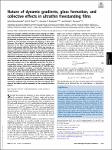Search
Author
- Alessio Zaccone (2)
- Nguyen K. Ngan (2)
- Asieh Ghanekarade (1)
- David S. Simmons (1)
- next >
Has File(s)
Search Results
Nature of dynamic gradients, glass formation, and collective effects in ultrathin freestanding films Molecular, polymeric, colloidal, and other classes of liquids can exhibit very large, spatially heterogeneous alterations of their dynamics and glass transition temperature when confined to nanoscale domains. Considerable progress has been made in understanding the related problem of near-interface relaxation and diffusion in thick films. However, the origin of “nanoconfinement effects” on the glassy dynamics of thin films, where gradients from different interfaces interact and genuine collective finite size effects may emerge, remains a longstanding open question. Here, we combine molecular dynamics simulations, probing 5 decades of relaxation, and the Elastically Cooperative Nonlinear Langevin Equation (ECNLE) theory, addressing 14 decades in timescale, to establish a microscopic ... |
We theoretically investigate high-pressure effects on the atomic dynamics of metallic glasses. The theory predicts compression-induced rejuvenation and the resulting strain hardening that have been recently observed in metallic glasses. Structural relaxation under pressure is mainly governed by local cage dynamics. The external pressure restricts the dynamical constraints and slows down the atomic mobility. In addition, the compression induces a rejuvenated metastable state (local minimum) at a higher energy in the free-energy landscape. Thus, compressed metallic glasses can rejuvenate and the corresponding relaxation is reversible. This behavior leads to strain hardening in mechanical deformation experiments. Theoretical predictions agree well with experiments. |
Physical properties of the pressure-induced activation volume and dynamic decoupling of ternidazole, glycerol, and probucol by the elastically collective nonlinear Langevin equation theory is theoretically investigated. Based on the predicted temperature dependence of activated relaxation under various compressions, the activation volume is determined to characterize effects of pressure on molecular dynamics of materials. It is found that the decoupling of the structural relaxation time of compressed systems from their bulk uncompressed value is governed by the power-law rule. The decoupling exponent exponentially grows with pressure below 2 GPa. The decoupling exponent and activation volume are intercorrelated and have a connection with the differential activation free energy. Rela... |
The temperature dependence of the reversible structural relaxation time and diffusion constant of metallic glasses under pressure is theoretically investigated. The compression not only changes the glassy dynamics, but also generates a metastable state along with a higher-energy state where the system can rejuvenate. The relaxation times for forward and backward transitions in this two-state system are nearly identical and much faster than the relaxation time without accounting for barrier recrossing. At ambient pressure, the expected irreversible relaxation process is recovered, and the numerical results agree well with prior experimental results. An increase in pressure has a minor effect on the relaxation time and diffusion constant that one computes without considering the influ... |


